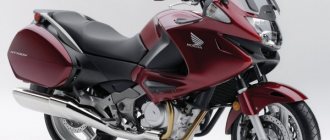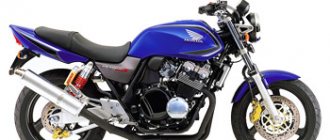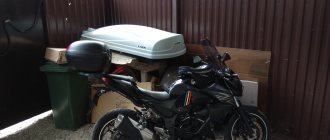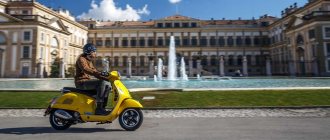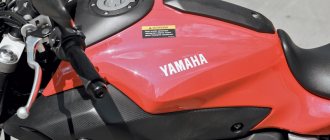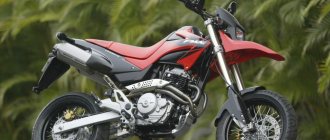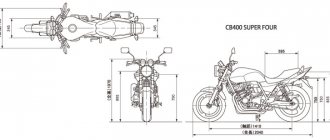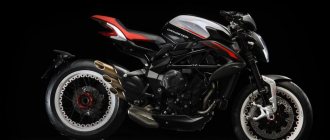| Honda CB500F (2013-2015) | Honda CB500F (2016-2021) | Honda CB500F (2022+) |
Honda CB500F naked model
was first presented in 2012 at the EICMA exhibition in Milan. The motorcycle has nothing in common with the Honda CB500 model, produced from 1994 to 2002, and is a completely different motorcycle.
At its core, Honda created a single platform for creating budget motorcycles of various classes, which were supposed to fill the niche of inexpensive motorcycles and models for beginner motorcyclists with a European driver's license category A2. So, in parallel, other versions were proposed - Honda CBR500R (sports) and Honda CB500X (enduro-tourist). These models are built on a common base, have the same engine and differ only in design, equipment and chassis characteristics.
The basis of the Honda CB500F was a specially developed in-line 2-cylinder liquid-cooled engine with a volume of 471 cm³, producing about 48 hp. power and 43 Nm of torque. A retuned version of this engine is also installed on the Honda CMX500 Rebel cruiser.
In 2021, the Honda CB500F model undergoes a slight restyling, receiving an LED headlight and brake light, increasing the fuel tank capacity by 1 liter, receiving new suspension (the front fork is now adjustable for preload) and a more modern exhaust shape.
In September 2021, Honda introduced the new generation CB500F. The motorcycle received lightweight wheels and a pendulum (total weight decreased by 3 kg), an inverted Showa SFF-BP fork, a double-disc brake system with radial 4-piston calipers, new control unit settings, a color LCD instrument panel and a new paint job.
Currently, the Honda CB500F model is produced in Thailand and sold in many countries around the world - Europe, North America, South America, Asia, Australia, etc.
The domestic Japanese modification of the model is the Honda CB400F.
The main competitors of the Honda CB500F in the class:
- Kawasaki ER-4
- Suzuki GSR 400 / Suzuki SFV400 Gladius
- Yamaha MT-03 (2016-)
Brief history of the model
- 2013 - start of production and sales of Honda CB500F. First generation
.
Model
: Honda CB500F;
Honda CB500F ABS (all regions). Factory designation
: CB500FD; CB500FAD.
- 2014 - no significant changes.
Model
: Honda CB500F;
Honda CB500F ABS (all regions). Factory designation
: CB500FE; CB500FAE.
- 2015 - no significant changes.
Model
: Honda CB500F;
Honda CB500F ABS (all regions). Factory designation
: CB500FF; CB500FAF.
- 2016 - restyling of the model. Second generation
. The model receives a more modern appearance, an enlarged fuel tank (15.7 l -> 16.7 l), new suspension (the front fork received preload adjustment), an LED brake light and headlight, and a new exhaust system.
Model
: Honda CB500F;
Honda CB500F ABS (all regions). Factory designation
: CB500FG; CB500FAG.
- 2017 - no significant changes.
Model
: Honda CB500F;
Honda CB500F ABS (all regions). Factory designation
: CB500FH; CB500FAH.
- 2018 - no significant changes.
Model
: Honda CB500F;
Honda CB500F ABS (all regions). Factory designation
: CB500FJ; CB500FAJ.
- 2019 - no significant changes.
Model
: Honda CB500F;
Honda CB500F ABS (all regions). Factory designation
: CB500FK; CB500FAK.
- 2020 - no significant changes.
Model
: Honda CB500F;
Honda CB500F ABS (all regions). Factory designation
: CB500FL; CB500FAL.
- 2021 - no significant changes.
Model
: Honda CB500F;
Honda CB500F ABS (all regions). Factory designation
: CB500FM; CB500FAM.
- 2022 - restyling of the model. Third generation
. The model receives an updated appearance, new lightweight wheels and swingarm, new ECU control unit settings (to increase traction at low and medium speeds), a new LCD instrument panel, Showa SFF-BP inverted fork, a new braking system (one front disc 320 mm was replaced by a 296 mm dual disc brake system, the 2-piston caliper was replaced by 4-piston radial calipers). The total curb weight has decreased by 3 kg. Slight change in overall dimensions (width increased: 790 → 800 mm, ground clearance decreased: 160 → 145 mm).
Model
: Honda CB500F;
Honda CB500F ABS (all regions). Factory designation
: CB500FN; CB500FAN.
Specifications
Technical characteristics of Honda CB500F:
| Model | Honda CB500F |
| Motorcycle type | naked |
| Year of issue | 2013+ |
| Frame | steel diagonal |
| engine's type | 2-cylinder, 4-stroke, in-line |
| Working volume | 471 cm³ |
| Bore/Stroke | 67.0 x 66.8 mm |
| Compression ratio | 10,7:1 |
| Cooling | liquid |
| Number of valves per cylinder | DOHC, 4 valves per cylinder |
| Fuel supply system | injector, PGM-Fi |
| Ignition type | fully transistorized |
| Maximum power | 47.6 hp (35.0 kW) at 8500 rpm 47.6 hp (35.0 kW) at 8600 rpm – CB500F (2022+) |
| Maximum torque | 43.0 Nm (4.4 kgm) at 7000 rpm 43.0 Nm (4.4 kgm) at 6500 rpm – CB500F (2022+) |
| Clutch | Multi-disc in oil bath, cable drive |
| Transmission | 6-speed |
| type of drive | chain |
| Front tire size | 120/70ZR17 M/C (58W) |
| Rear tire size | 160/60ZR17 M/C (69W) |
| Front brakes | 1x 320mm disc, 2-piston caliper (CB500FA - ABS) 2x 296mm disc, 4-piston radial caliper (CB500FA - ABS) - CB500F (2022+) |
| Rear brakes | 1 disc 240 mm, 1 piston caliper (CB500FA - ABS) |
| Front suspension | 41mm telescopic fork (non-adjustable), 122mm travel – CB500F (2013-2015) 41 mm telescopic fork (adjustable preload), travel - 120 mm - CB500F (2016-2021) 41mm Showa SFF-BP inverted fork, 108mm travel – CB500F (2022+) |
| Rear suspension | pendulum Pro-Link with monoshock absorber (adjustable preload), stroke - 105 mm - CB500F (2013-2015) pendulum Pro-Link with monoshock absorber (adjustable preload), stroke - 119 mm - CB500F (2016+) |
| Length | 2075 mm – CB500F (2013-2015) 2080 mm – CB500F (2016+) |
| Width | 780 mm – CB500F (2013-2015) 790 mm – CB500F (2016-2021) 800 mm – CB500F (2022+) |
| Height | 1060 mm |
| Wheelbase | 1410 mm |
| Minimum ground clearance (clearance) | 155 mm – CB500F (2013-2015) 160 mm – CB500F (2016-2021) 145 mm – CB500F (2022+) |
| Seat height | 785 mm |
| Acceleration 0-100 km/h (0-60 mph) | 6.03 sec[1] |
| Maximum speed | 172 km/h[2] |
| Gas tank capacity | 15.7 l – CB500F (2013-2015) 17.1 l – CB500F (2016+) |
| Motorcycle weight (curb) | 190 kg – CB500F 192 kg – CB500FA (ABS) 189 kg – CB500FA (ABS) – CB500F (2022+) |
Review of the Honda CB 500 motorcycle
This small roadster, unfortunately, is quite rare in Russia. In Europe, on the contrary, the SV500 is very popular. Now, of course, the situation there is changing - age: they stopped making the two-cylinder seabisha in 2001 due to environmental concerns. The successor was the CBF500 - injection, with a catalyst, with a different rear suspension... but that's another story.
So, CB500 1995, Japanese assembly (later assembled by Italian brothers), eight-valve two-cylinder engine, 180-degree crankshaft, 57 horsepower, duplex steel frame, 37 mm fork at the front, double shock absorbers and drum brake at the rear. In general, a classic in a more or less modern version, Japanese “Java”.
After I took it, at the very beginning of last season, quite a lot of forced work was done and a lot was done due to incontinence - my favorite technique. She didn’t let me down on the road, and even with a dead relay-regulator and a dead battery, she took me to the service station this year.
What can we say: it is clear that there are motorcycles that are incomparably faster and more modern. I am a witness: I took a ride on the carburetor R1 this year and... The R-ka amazed me, and not with its gun-like dynamics, but in general - a wonderful, obedient technique! In walking mode, it turned out to be much easier to ride than a Sibikh, but, let me make a reservation, I did not experience traffic jams, row spacing and other Moscow joys. Okay, I got distracted, I remembered, my palms were already sweating...
In general, there are so many advantages in the seabisha that all temptations to sell it and switch to something “better” were eventually swept away. If you ask me about the advantages, I won’t single out anything separately, but in totality everything is good: light; narrow on the steering wheel; a motor with a wide range - and it drives from below, and you can turn it, again, “kopeck piece” (I like it); in 5 seconds it accelerates to 100, not 200; if you hit more gears, it eats up a little - 270 km to reserve (tank 18 l); good tires handle well; the suspension copes with the task; glove box under the saddle; simple; "inconspicuous"; a little retro. Its main advantage is its versatility: it’s good in the city, it’s good outside the city, and you can go off the road onto hard ground. Of the minuses: for my 183 cm (90 kg) it is a little too small, although in sports the knees are even more bent, but everything is different there..., weak brakes, weak standard lights, a little “rough” gearbox (although this may be shaky), very feels the second - it is single-seater.
In conclusion: the mileage as of today is 62 thousand (maybe 162...?), oil consumption is 100 g per 5 thousand km, she carries me and carries me, she doesn’t ask for porridge. I repeat, I don’t see any alternative yet in terms of price/quality/application combination. The next “broom”, I think, will be some kind of endura. I liked the “small” Yamaha Tenere. More good and different technology! Friends, good luck to everyone!
Riding it is a pleasure. In urban conditions, this is simply ideal, smooth engine operation throughout the entire speed range. No jerking. The volume of ONLY 500 cm³ is ideal for beginner motorcyclists. CB is able to accelerate smoothly and forgives many flaws. If this is not enough for you, unscrew the throttle and you will be pleasantly surprised by the uniform acceleration! Let’s just say that this is quite enough to “make a mess” for the second number. With my weight of only 55 kg, the motorcycle at a traffic light even managed to grind during acceleration or tear the front wheel off the asphalt. A little effort is enough for the motorcycle to stand on the rear wheel (some stunt riders, by the way, started with the CB 500). In general, everything regarding driving around the city - there are no complaints.
There were no questions outside the city either. The motorcycle confidently accelerates to 160–170. I didn’t see the promised 185 (well, let’s make an allowance for the fact that I came across an old ’94 without fairings). The only thing was that the lack of power was noticeable when driving with number two on a two-track road (one lane, another lane). The engine did not have enough power to make the necessary burst from 120 km/h to overtake oncoming traffic. Although it is understandable: this is not what this motorcycle is for.
The CB-hi engine is generally beyond any praise. I will say one thing: HE IS UNKILLABLE. Honda has done very well in this regard. Your mufflers will rust and burn out, but the engine will continue to work no matter what!
The bike feels very comfortable. Direct landing, comfortable sitting. Both the first and second numbers will feel comfortable. The motorcycle is incredibly light and obedient, easy to corner. In city traffic conditions, there is nothing better. But this becomes a slight disadvantage at high speeds. On the highway it starts to sway a little in the wind, and it’s better not to be near trucks at all.
The Honda CB 500 motorcycle is simply ordered for those who are just learning to ride. It’s simply impossible not to love him. This, of course, is not a wild mustang of the free prairies, but under the guise of a quiet pony hides the heart of a racer who will give a light to many at a traffic light. As for maintenance, the motorcycle is very unpretentious. I already mentioned that the engine is indestructible. Another nice thing is that spare parts for it are inexpensive and there are plenty of them!
The Honda CB500 is one of the ultimate classics. Driving around the city on it is a pleasure. Between cars, this motorcycle literally flows like water. It steers great. It turns well, however, if the asphalt is smooth. Even small irregularities throw it off the trajectory - the suspension is the simplest. In my opinion, the first speed is a little short; from the traffic light, already in the middle of the turn, you want to tuck in the second. And the most important thing is that the motorcycle allows you to do this if the inclination is not critical. Without any fears. The acceleration is enough to tear through any cheap four-wheel street racer. The engine spins up to 10,500 rpm. Acceleration is smooth, without jerks. The box works perfectly, clearly. For the city, the first three gears are enough. But this is in the city. But outside the city the song is different. At a speed of 110 km/h the wind begins to strain. It’s good that the saddle has a notch, that is, the fifth point rests on a pronounced step, otherwise it would blow away. I really don’t like the speed of 120 km/h, because at this speed the tachometer shows 6000 rpm, and at these speeds the vibration is the highest. But 140 km/h is perhaps the ideal speed for the SV500 (with a windshield). During the trip, SiBishka showed herself to be a cheerful person. But we must pay tribute - this is not a motorcycle for touring. When the side 44-liter panniers are loaded, the sausage appears at a speed of 60 km/h. The sausage is not big, you can hold the steering wheel, but only with two hands. The bike feels bad on gravel. It's better not to get into the mud. Since the landing is slightly tilted forward, after a while the hands begin to numb. The motorcycle itself is not tall; with my height of 179 cm, I place my feet on the asphalt and at the same time my knees are slightly bent. This leads to another drawback - the small distance from the saddle to the footpegs. For me it’s just right, but if it were a little higher it would be strained. The stock round rearview mirrors are depressing. Half of the image is your own shoulders. I was pleased with the gasoline consumption - 5.5 liters at a speed of 100 km/h with one rider and two side cases. With a tank of 18 liters, such fuel consumption allowed me to start looking for a gas station after 250 km.
During the entire period of operation, I only changed consumables. There were no breakdowns. Start with half a turn. Even after a winter parked in a cold garage, the starter spun just long enough to fill the carburetors. I also went in a slight frost (about -3 degrees Celsius). No problem.
Over time, I equipped my motorcycle with Hepco+Becker roll bars, a WingRack2 luggage system, two 44-liter Motodetail panniers and one 37-liter Louis topcase, and a tank bag from Motodetail. The Givi wind deflector was already with the motorcycle, otherwise I would have had to splurge on it. Installed a motorcycle alarm with a pager.
Who can I recommend this motorcycle to? Firstly, for beginners, since the bike is absolutely adequate and forgives many mistakes that are inevitable at first. Secondly, for those who drive mainly around the city, but at the same time preach a relatively calm driving style. Thirdly, for those who need a simple, inexpensive and unpretentious bike. And, fourthly, for those who love classics in all its forms.
